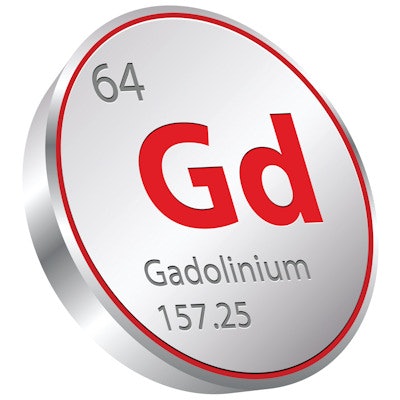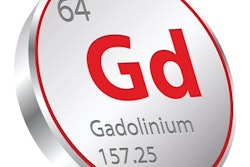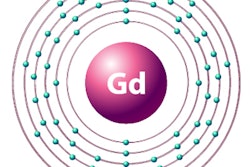
Five or more doses of the macrocyclic gadolinium-based contrast agent (GBCA) gadobutrol resulted in no increase in T1-weighted signal-intensity ratios in the globus pallidus or dentate nucleus of pediatric patients, a sign of no gadolinium deposition in these patients, according to a June 26 paper in Radiology.
The researchers from Canada also found no increase in signal intensity among pediatric patients who received 14 or more administrations of gadobutrol, prompting them to conclude that "repeated administrations of gadobutrol do not lead to deposition of gadolinium in the pediatric brain."
Prior studies have found higher levels of deposition with linear GBCA agents, while macrocyclic agents seem to have lower or no detectable levels of deposition. This has led some researchers to recommend the use of macrocyclic GBCAs in children.
Gadobutrol (Gadavist, Bayer HealthCare), a macrocyclic GBCA, was approved by the U.S. Food and Drug Administration in December 2014 for use in MRI scans of the central nervous system in children younger than 2 years. However, there are few studies of gadobutrol in pediatric patients, the authors noted.
Therefore, first author Dr. Ravi Bhargava from the University of Alberta and colleagues wanted to investigate whether gadolinium deposition occurred after the administration of gadobutrol, with an increase in T1 signal intensity as a sign of deposition. Their retrospective study included 91 children with brain tumors (median age, 5.4 years; range: 0-17 years). The subjects underwent five or more 1.5-tesla MRI brain scans with gadobutrol between January 2009 and July 2017.
To see if gadolinium deposition occurred at higher levels of contrast administration, the researchers also analyzed a subset of six patients who received 14 or more doses of the agent (median dose, 64 mL; range: 40-91 mL).
Bhargava and colleagues calculated T1 signal-intensity ratios for the globus pallidus to the corpus callosum and the dentate nucleus to the corpus callosum. The measurements were conducted from the first to sixth unenhanced MRI brain scan. In reviewing the results, they found no significant difference between the T1 signal-intensity ratios.
| Change in signal-intensity ratio after use of gadobutrol in MRI | ||
| Region | Change | p-value |
| Globus pallidus | 0.018 ± 0.087 | 0.17* |
| Dentate nucleus | -0.015 ± 0.11 | 0.44* |
As for the pediatric patients who had more than 14 administrations of gadobutrol, there also were no changes in the globus pallidus (p = 0.15) or dentate nucleus (p = 0.50).
While the clinical effects of gadolinium deposition are still unknown, children could be more susceptible to any toxic effects, the researchers noted. Therefore, it may be wise to move from linear to macrocyclic GBCAs for pediatric use.
"Regardless of the current lack of understanding of the consequences of gadolinium deposition in the brains of children, the overall risk stratification of GBCAs for nephrogenic systemic fibrosis and brain and bone deposition of gadolinium indicate that a shift toward the use of lower-risk macrocyclic GBCAs such as gadobutrol may be prudent, particularly in a pediatric population, as awareness of gadolinium deposition in the pediatric brain increases," they concluded.



















